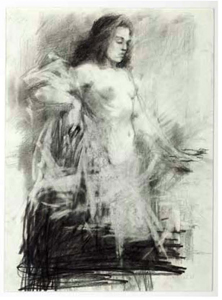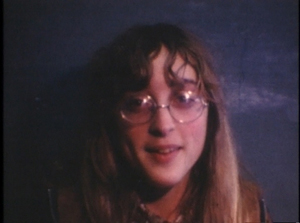 Forget Me images Back to first Wedman page  Above: Neil Wedman (Canadian, born 1954), Study of the Bizarro World, 2003, watercolour on paper. Courtesy the artist and the Art Gallery of Ontario. DON'T FORGET ME: NEIL WEDMAN'S 1970 HIGH SCHOOL SCREEN TESTS By Cliff Eyland Neil Wedman lives in Vancouver, where he was born. The son of noted film critic Les Wedman, he studied at the Vancouver School of Art from 1973 to 1977, graduating with a degree in Media Communications. He has since had many solo and group shows in Canada, but this is his first solo exhibition in Winnipeg. The Art Gallery of Ontario, on the occasion of his 2004 solo show there, called Wedman "an eccentric at the very heart of the contemporary Vancouver art scene," a characterisation that I take as a nod to his eclecticism, independence and originality. More from the AGO on Bizarro World: The series depicts the Bizarro World, a weird counterpart to Earth introduced by DC Comics in 1958, as the setting for a simultaneously mutant and id-like parody of its banner Superman series. Wedman imagines the cubic planet as a deviant precursor to Minimal Art and Earthworks, in large-scale paintings on paper, which contrast the heroics of 1960s art movements with the daintiness of watercolour technique. [From the AGO website accessed on 24 December 2010: http://www.ago.net/present-tense-neil-wedman]  Above: Neil Wedman (Canadian, born 1954), Study for Black Bride, 1990. graphite pencil drawing on paper, 44.3 x 35.7 cm. Courtesy of the artist. Wedman is an ideal artist to show at an art school gallery because he is accomplished in so many media, including drawing, video, painting and bookmaking. The breadth of his work is admirable, suggesting to me conceptual connections to artists such as Charles Ray and Tom Friedman who have no signature style and who treat art making as invention. Wedman's art often pivots on a point from which both vernacular and high art can be surveyed. In works such as Bizarro World the austere art of minimalism is parodied in allusions to DC comics; in Electric Ladyland pop culture meets the conceptual art practice of text painting; and in his earlier Brides work Duchamp is referenced by means of the ancient vernacular practice of life drawing.  Above: Neil Wedman (Canadian, born 1954), Crosstown Traffic, 2004. Oil on canvas, 129.5 x 129.5 cm. Courtesy of the artist. Forget Me consists of "screen test" film clips Wedman shot in 1970, when he and his subjects were teenagers. The tape's music is by the 1980s band The Cure, a tune called Plainsong. The original film was shot not by me but under my direction by some forgotten, anonymous buddy whose dad had a movie camera. That was in 1970 and I was fifteen or sixteen years old. I am the person off camera on the left to whom the subjects respond. I can't remember what I was saying to them, just asking non-sequitur type questions I think.... The film was shot in a classroom at the high school we all attended and the on-camera participants were assembled through a kind of open casting call...[e-mail to the author, 2010]  Above: Neil Wedman (Canadian, born 1954), still from Forget Me, 1970-2000, single channel video. Photo credit: Stuart McCall. Courtesy of the artist. I first saw Forget Me at its Vancouver Art Gallery debut in the year 2000, and I found it mesmerising. I returned again and again to see it. Forget Me is about desire, longing, and an artistic engagement with the Muse that is frowned on these days. Witness Marina Roy's review: Neil Wedman's Warhol-like Forget me manipulates film footage that he shot in 1970 to make a video that fetishizes the laughing faces of fifteen blond nubile former schoolmates. Wedman's use of slow motion and epic goth music within the video speak, rather regressively, of spectacle, seduction, and white middle class ideals of feminine beauty. The manipulation and framing of beautiful faces makes these young women look already dead (facilitating erotic projection). Conceptually, the historical lapse of thirty years highlights what had become cutting edge in the '70s, and what is embraced as nostalgic distance now. [Marina Roy, "These Days," 2001. Article accessed online at http://www.marinaroy.ca/these_days.htm on 20 August 2010]Roy conjures a vision of what "progressive" and "regressive" art might look like now, even though this terminology has disappeared from the art discourse everywhere, except, I take it, in Vancouver. Roy would like the work much better, no doubt, if Wedman had dressed up the schoolgirls as young pioneers in a Rodchenko-like vision of a Soviet future. However, we can take something from Roy's reaction: Forget Me is likely to receive what are called gendered responses, that is, viewers are likely to either identify with the teenaged subjects or the artist. More generally, perhaps, they are likely to make their own aesthetic reconciliations while contemplating a work made in the year 2000 with 1970s hippie-era girl head shots and a 1980s Goth soundtrack. This work took thirty years to gestate, and it is richer for it. The awkwardness of (most of) Wedman's subjects is striking, so unlike contemporary teenagers, who know how to instantly pose for the camera, and, of course, so unlike Warhol's 1960s art world hipsters, who gazed into his camera with such self assurance. If Forget Me is a paean to anything, it may not be to lost innocence, but rather to the disappearance of "camera shy" responses. We look at these girls' hair styles and glasses in order to see where they fit within the perpetual recyclings of commercial culture. We speculate about what they might look like now as women in their late fifties, about where they might live, or even whether they are still alive. As anonymous subjects, we may wonder whether or not the circulation of Wedman's tape will coax his subjects out of -- perhaps unintentional -- hiding. We can't be sure about who they really were in 1970, other than students in a Vancouver high school, but who -- and where -- are they now? |